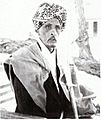Monarch facts for kids
A monarch is a ruler who gets their power because they are part of a special family. This way of ruling is called a monarchy. In a monarchy, power usually passes down from one family member to another, often from parent to child. This creates a ruling family line known as a dynasty.
A male monarch is often called a king or an Emperor. A female monarch is usually called a queen or an Empress.

History of Monarchs
Monarchs were very common throughout history. Many countries used to have monarchs as their main leaders. Today, some countries still have monarchs, but they might not have all the power. Instead, other leaders, like a president or prime minister, make most of the decisions.
Types of Monarchs and Titles
Monarchs often ruled over different levels of land or groups of people. For example, a large Empire could include several smaller kingdoms. A kingdom might then have several duchies or principalities within it.
The title a monarch uses often depends on the size or type of land they rule. A Prince or Princess can mean they are the ruler of a 'Principality'. It can also mean they are the son or daughter of a King or Queen. Other languages sometimes have different words for these roles.
Here are some common titles for monarchs and their families:
| Title | Male Ruler | Female Ruler |
|---|---|---|
| Empire | Emperor | Empress |
| Kingdom | King | Queen |
| Grand Principality | Grand Prince | Grand Princess |
| Principality | Prince | Princess |
| Archduchy | Arch Duke | Arch Duchess |
| Grand Duchy | Grand Duke | Grand Duchess |
| Duchy | Duke | Duchess |
| Marquisate | Marquess | Marchioness |
| County | Count | Countess |
| Viscounty | Viscount | Viscountess |
| Barony | Baron | Baroness |
See also
Images for kids
-
The Nine Sovereigns at Windsor for the funeral of King Edward VII, photographed on 20 May 1910. Standing, from left to right: King Haakon VII of Norway, Tsar Ferdinand of the Bulgarians, King Manuel II of Portugal and the Algarve, Kaiser Wilhelm II of Germany and Prussia, King George I of the Hellenes and King Albert I of the Belgians. Seated, from left to right: King Alfonso XIII of Spain, King George V of the United Kingdom and King Frederick VIII of Denmark.
-
Postcard from 1908 showing nineteen of the world's reigning monarchs: (left to right) King Rama V/Chulalongkorn of Siam, King George I of Greece, King Peter I of Serbia, King Carol I of Romania, Emperor Franz Joseph of Austria-Hungary, Tzar Ferdinand I of Bulgaria, Sultan Abdul Hamid II of the Ottoman Empire, King Victor Emmanuel III of Italy, Emperor Nicholas II of the Russia, King Edward VII of Britain, Emperor Wilhelm II of Germany, King Gustav V of Sweden, King Haakon VII of Norway, King Frederick VIII of Denmark, Queen Wilhelmina of the Netherlands, Guangxu Emperor of China, Meiji Emperor of Japan, King Manuel II of Portugal and King Alfonso XIII of Spain.
-
Ramesses II (r. 1279–1213 BC), the third Pharaoh of the Nineteenth Dynasty of Egypt
-
From left to right, Japanese Emperor Hirohito, Crown Prince Akihito, Crown Princess Michiko and Empress Nagako, 1959
-
Sultan Mehmed III from Ottoman Dynasty
-
King Norodom Sihanouk of Cambodia
-
Sri Lankan King Devanampiya Tissa, Queen consort Anula, and Prince Uththiya, c. 307 BC
-
Jacques I, Emperor of Haiti, 1804
-
Pedro II, Emperor of Brazil, by Delfim da Câmara
-
Francisco Pizarro meets with the Inca emperor Atahualpa, 1532
-
Kamehameha IV, King of Hawaii
See also
 In Spanish: Monarca para niños
In Spanish: Monarca para niños













